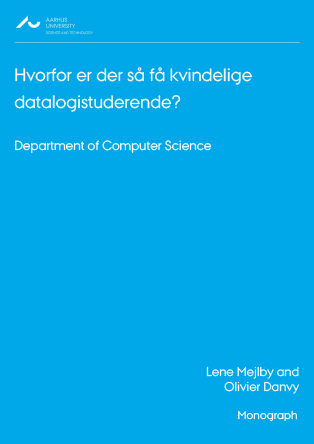Hvorfor er der så få kvindelige datalogistuderende?
Contributors
Synopsis
This Master's thesis investigates the reasons why there are so few female students in Computer Science. More specifically, the thesis investigates what attracts both men and women to computer science, on what criterions they base their choice of education, and which pros and cons women experience as a result of their gender during their studies and later in their worklife. Furthermore, the study looks into the assumptions of current students and graduates concerning why so few women are attracted to Computer Science.
The reason for investigating this subject is that there is a rising need in Denmark for people with higher education in IT – especially within the traditional, theoretical, mathematical founded fields of education such as Computer Science. Surprisingly few women apply for these fields compared to traditional other scientific ones. The investigation employs qualitatively designed online questionnaires. They are evaluated through Healy and Perry's assessment criterions. The evaluation is extended by Guba and Lincoln's transferability criterion. A total of 139 students, graduates and former participants in it-camp for piger (IT Camp For Girls) responded to the questionnaires. The analysis of their answers shows that on the whole, women are attracted to Computer Science because of its mathematical foundations. It also shows that both men and women presume that the low number of female applicants to Computer Science is caused by various factors including the following ones: the education is dominated by men, prejudices concerning women's technical abilities are prevalent, and the education suffers from a poor image, since computer scientists are pictured as stereotypical geeks spending their life alone at their desk.
It might be worthwhile to expand the investigation to include, for instance, respondents from other countries or with another education.
References
Blum, L., Frieze, C., Hazzan, O., and Dias, M. (2007). A cultural perspective on gender diversity in computing. Retrieved from lblum@ cs. cmu. edu on May, 1:1.
Cafebabel.com (Marts,2009). Europe’s ‘cyberella’ girls to get more it skills. http://www.cafebabel.co.uk/article/29242/viviane-reding-women-ict-skills-technology.html.
ComputerWorld (Marts, 2007). Eu vil have flere kvinder i it-branchen. http://www.computerworld.dk/art/38369?cid=2&q=Politik&a=cid&i=2&o=1&pos=2.
ComputerWorld (Marts 2008). Df og sf klar til at give datalogi-faget et løft. http://www.computerworld.dk/art/44688/df-og-sf-klar-til-at-give-datalogi-faget-et-loeft.
Datalogisk Institut, A. U. (2006). Evaluering af studievalg og studieinformation for rus-årgang 2006 på datalogisk institut. Aarhus Universitet.
Fink, A. (2009). How to Conduct Surveys: A Steb-by-Step Guide 4th ed. SAGE Publications, Inc.
Guba, E. and Lincoln, Y. (2005). Paradigmatic Controversies, Contradictions, and Emerging Confluences. The Sage handbook of qualitative research (3rd ed.). Thousand Oaks, CA: Sage.
Hansen, N.-H. M., Marckmann, B., and Nørregård-Nielsen, E. (2008). Spørgeskemaer i virkeligheden. Forlaget Samfundslitteratur.
Healy, M. and Perry, C. (2000). Comprehensive criteria to judge validity and reliability of qualitative research within the realism paradigm. Qualitative Market Research: An International Journal, 3(3):118–126.
IBM (set september 2010). Teknologi og piger. http://www-05.ibm.com/dk/info/top/.
Institut, D. (2010). Datalogisk institut (aarhus universitet). http://da.wikipedia.org/wiki/Datalogisk_Institut_(Aarhus_Universitet).
Jørgensen, S. T. (Juni 2009). Gæsteblogger: Datalogi-faget (gymnasiet og it - 4). http://bizzen.blogs.business.dk/2009/06/25/g%C3%A6steblogger-datalogi-faget-gymnasiet-og-it-4/.
Kildebogaard, J. (August, 2009). Datalogi i gymnasiet er ved at uddø. http://www.version2.dk/artikel/11752-datalogi-i-gymnasiet-er-ved-at-uddoe.
Kruuse, E. (2005). Kvalitative forskningsmetoder - i psykologi og beslægtede fag. Dansk Psykologisk forlag.
Kvindegruppen ved naturvidenskabeligt fakultet, A. U. (Maj 1986). Kvinder og “mandefag”. Kvindegruppen.
Lincoln, Y. and Guba, E. (1985). Naturalistic inquiry. Sage Publications, Inc.
Microsoft (2009). Digigirlz - programs@microsoft. http://www.microsoft.com/about/diversity/programs/digigirlz/default.aspx.
Mogensen, T. (Juli 2008b). Kvindelige datalogistuderende. http://www.version2.dk/artikel/7826-kvindelige-datalogistuderende.
Mogensen, T. (Marts, 2008a). Afskaf datalogi i gymnasiet. http://www.version2.dk/artikel/6499-afskaf-datalogi-i-gymnasiet.
naturvidenskabelige fakultet ved Københavns Universitet, D. (Januar 1988). Hovedområdet særnummer - kvinder på naturvidenskab. Eks-skolens trykkeri.
Neergaard, H. (2007). Udvælgelse af cases - i kvalitative undersøgelser. Forlaget Samfundslitteratur.
Nicolajsen, H. W., Sørensen, L. T., and Schultz, N. (2007). In search of female it-students. IRIS31.
Njor, M. (22. februar, 2008). A2 + b2 = totalt ligegyldig viden2. Klumme i MetroXpress, http://www.metroxpress.dk/dk/article/2008/02/22/08/0745-66/index.xml.
People, F. (2010). Piger og it. http://www.futurepeople.dk/piger-og-it/.
Politiken.dk (Juni, 2010). It-branchen råber på flere kvinder. http://politiken.dk/uddannelse/article999772.ece.
Prosa (Februar, 2009). It kan vi ikke undvære. http://www.prosa.dk/aktuelt/prosit/artikel/artikel/it-kan-vi-ikke-undvaere/?tx_prosamag_pi1%5Bpageid%5D=.
Radio, D. (December, 2009). It-branchen mangler arbejdskraft. http://www.dr.dk/Nyheder/Penge/2009/12/24/091728.htm.
Schrøder, K., Drotner, K., Kline, S., and Murray, C. (2003). Researching Audiences. Hodder Arnold.
Spertus, E. (1991). Why are there so few female computer scientists.
Svanborg, K. (2009). Studiemiljøundersøgelse: En undersøgelse af studiemiljøet og de studerendes trivsel på datalogisk institut, aarhus universitet. Aarhus Universitet.
Thiemann, P. (17. april 2010). Kvindekvoter kan blive pinlig pynt. http://politiken.dk/erhverv/949770/kvindekvoter-kan-blive-pinlig-pynt/.
Toft, D. (2009). Lykkelig i Nørdland. Gyldendal.
Uddannelsesguiden (2010). Uddannelse: Datalogi. http://www.ug.dk/uddannelser/universitetsuddannelser/naturvidenskabeligeuddannelser/matfyskemidatalogi/datalogi.aspx.
Uddannelsesguiden (8. decemper 2009). Beskæftigelsesudsigter for naturvidenskabelige uddannelser. http://www.ug.dk/job/artikleromjobogarbm/beskaeftigelsesudsigter/enkeltefagoguddgrupper/beskaeftigelsesudsigter_for_naturvidenskabelige_uddannelser.aspx.
Universitet, A. (2010a). Bacheloruddannelsen i datalogi - introduktion. http://studieinfo.au.dk/bachelor_introduktion_dk.cfm?fag=7040.
Universitet, K. (2010b). Bachelor i datalogi. http://studier.ku.dk/bacheloruddannelser/datalogi/.
Version2 (September 2009). Datalogi-lærere får kold skulder: Vil ikke genoplive døende fag. http://www.version2.dk/artikel/12097-datalogi-laerere-faar-kold-skulder-vil-ikke-genoplive-doeende-fag.
Weiner, Z. (Maj 2010). Boys toys. http://www.smbc-comics.com/index.php?db=comics&id=1883.
Wikipedia (April, 2010). Qualitative research. http://en.wikipedia.org/wiki/Qualitative_research.
Wikipedia (November 2009). Quantitative research. http://en.wikipedia.org/wiki/Quantitative_research.
XKCD.com (Marts 2008). How it works. http://www.xkcd.com/385/.
Yin, R. K. (2009). Case Study Research: Design and Methods (4th ed.). Thousand Oaks, CA: Sage.
Author Biography
Associate professor
Department of Computer Science
Aarhus University, Denmark

